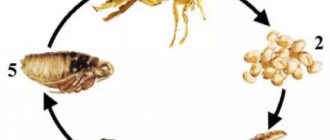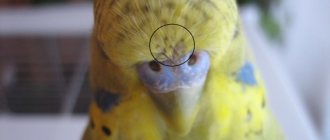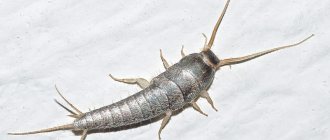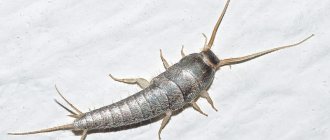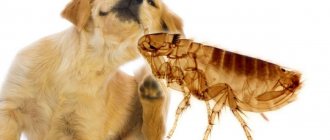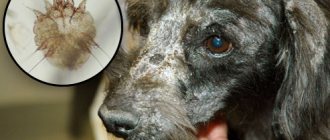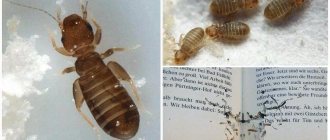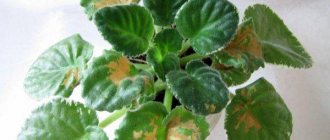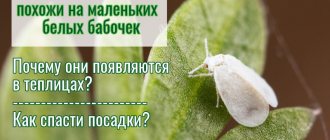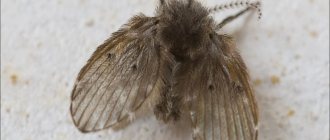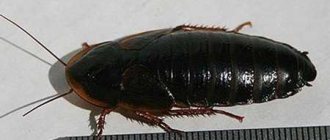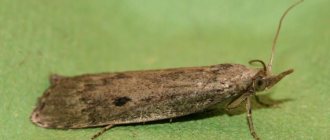Fleas are blood-sucking insects that parasitize the skin of warm-blooded animals, which means not only animals and birds, but also humans. It is accepted that dogs are parasitized by the “dog” flea - Ctenocephalus canis.
However, the most common type is the “feline” one - Ctenocephalides felis felis, they are most often found on cats and dogs, and therefore on humans. It is on cat fleas that the effect of new drugs is tested (if it works on them, it will work on other fleas).
Flea classification
Today there are more than two thousand species of fleas. It is almost impossible to distinguish them from each other without special equipment and without sufficient knowledge. However, without going into scientific terminology, they can be classified as follows:
- canine;
- felines;
- human;
- rat;
- chicken
What do fleas look like on dogs? (photo)
The flea's body has a laterally compressed shape and is covered with scales, bristles and spines. In length it reaches from one to five millimeters, although there are especially twice as many. The mouthparts are piercing-sucking type. Fleas do not have wings, which gives them additional maneuverability in the thick fur of animals. The long, strong limbs on the abdomen allow them to move quickly. The photo shows what fleas look like on a dog under a microscope and in real size.
Prevention of infection
Use collars as a preventative measure after treatment with drops and sprays, but only after two to three weeks. The duration of action of the active substance is from 2 to 7 months. Cost from 80 rub. up to 1.5 thousand rubles To prevent infection, place branches of wormwood, lemon balm, lavender around the house, fill the litter with sawdust from coniferous trees - pine, juniper, spruce. Be sure to give your dog an anti-helminth medication after removing fleas to eliminate the risk of infection. After all, fleas are active carriers of tapeworms and other parasites. Don't forget that you too have been in contact with an infected animal. Take care of prevention for yourself and your loved ones.
Video
Peculiarities of breeding dog fleas
The parasite multiplies at an incredible speed, but prefers to do this not on the animal’s body, but in secluded places in the external environment. On carpets, in cracks behind baseboards or in fallen leaves. Once every few days, the female lays a large number of eggs from which larvae emerge, which outwardly resemble small caterpillars covered with a dense protective shell. They feed on organic waste and, after several molting cycles, transform into a sexually mature individual awaiting a new victim.
Cat lice: dangerous for the animal, but not contagious for humans
Lice are small, wingless insects with a flattened body. They are host specific. Unlike other external parasites, cat lice cannot live or move around in the environment. They spend their entire life cycle on a host animal. There are several types of lice. The most common parasite in cats is Felicola subrostratus.
The presence of lice is dangerous for your pet. When severely infected they cause:
- Itching
The itching is irrepressible, incessant, preventing your cat from living peacefully. By parasitizing the pet's fur, lice thin it, make it disheveled, sloppy, and cause the cat a lot of anxiety.
- Feline eczema
A severe infestation of lice can lead to miliary dermatitis, or feline eczema. It causes numerous blisters and bumps to form on the cat’s skin, with inflamed skin underneath. The affected areas of the skin are very itchy, the cat scratches them, and the wounds become infected. This only worsens the course of the disease.
Lice are also carriers of helminth eggs. As a result of this, helminthiasis and general exhaustion are added to the skin lesions of the infected animal. Lice spend most of their time attached with their paws to the base of an infested cat's hair. They feed on the epidermis, secretions of the sebaceous glands and blood.
Female lice lay eggs called nits. During her life, the female parasite lays 20-60 eggs and fixes them to the root part of the hair. After 7-12 days, the eggs hatch into larvae that look similar to adults, which after three molts turn into mature insects.
In large quantities, cat lice accumulate on the head, neck and at the base of the tail. These parasites infect pets of all breeds, except hairless cats. They are most often found in animals with long and thick hair.
Where do dogs get fleas?
Where can a dog pick up fleas and where do they come from? Anywhere, in fact. Fleas can live both outdoors and indoors, in basements. In the grass, in fallen leaves and even on bare ground. The risk of infection is always present, whether the dog is walked in the yard of a house, in specialized areas or in a dense forest. Even a dog that is not outdoors can be infected with parasites from other pets or neighbors. Fleas easily migrate from the entrance to the apartment through the open front door.
Parasites are incredibly jumpy, so even if you don’t let your pet get too close to other four-legged animals, you can’t be completely sure of its safety.
Many owners are very surprised how their exclusively domestic pet was able to “catch” parasites? It's very simple; insects and their larvae can be carried on clothes or the soles of shoes. They can enter the house even through open windows on the first floors.
Signs of fleas in a dog
The main signs of a dog being infected with fleas are:
- restless behavior and aggressiveness;
- constant scratching;
- increased shedding and the appearance of bald spots;
- wounds, sores and redness on the skin.
If symptoms are detected, it is necessary to examine the dog's coat. Pay special attention to the places on the withers, belly and behind the ears. Small brown insects, white eggs or tiny dark balls of excrement are fairly easy to spot.
Why are dog fleas dangerous?
Why are fleas dangerous for dogs? They cause discomfort to the pet and can serve as carriers of dangerous infections and diseases, such as plague, typhoid, encephalitis, as well as worm and salmonella eggs.
Many dog breeders believe that fleas are not dangerous to people and live exclusively on animals, while others fear that fleas from a dog can pass to humans. This is not entirely true. The parasite is not able to live permanently on humans, but it can bite. The consequences of a dog flea bite on a person can be serious if the flea is infected. In addition, a severe allergic reaction may occur.
Larvae
The female begins the process of reproduction immediately after fertilization. Lays 5 to 12 eggs daily. She shoots them over long distances wherever necessary. Does not build special nests. The eggs roll onto the floor, into the grass, animal bedding, or rug. Over its entire life it is capable of laying about 500 eggs.
The larvae develop inside the egg for about 2 weeks. They are absolutely invisible to others, since they have miniature dimensions - 0.5 mm. The appearance of the larvae differs significantly from adult fleas, as does their lifestyle.
Reproduction of dog fleas
The larvae are born as small white worms. Body length is about 1 mm. They hide from the sun's rays, feed on waste, dead particles of the epidermis, and feces.
The full development cycle of flea larvae lasts 20 days. During this time, up to 5 moults pass, each time increasing in size. At the last stage it pupates, after 2 days a full-fledged flea appears and immediately begins mating.
Effective flea treatments for dogs
Any pet store now has a sufficient range of anti-flea drugs. The most common means are listed below. Their cost ranges on average from 100 to 700 rubles.
Shampoos
Shampoos have a rather preventive effect; their effect is short-lived. Based on their composition, they are divided into two types: based on natural ingredients and based on insecticides. The use of the latter should be approached with caution, as they can cause an allergic reaction.
When using, it is important that the composition does not come into contact with the mucous membranes and eyes of the animal during bathing. Carefully read the instructions for using the shampoo, it describes whether you can bathe puppies with it. Shampoos are usually harmless if they do not enter the body.
Average cost of flea shampoo: 150 rubles.
Sprays
Anti-flea sprays are quite effective, but problematic to use. When using, you need to protect yourself with a respirator and rubber gloves and do not direct the spray at the animal’s face. In addition, it is important to prevent licking the fur for several hours, otherwise a number of side effects may occur, such as vomiting and difficulty breathing. If this happens, you should contact a veterinary clinic, indicating which product was used.
You should try to spray the spray not on the dog’s fur, but on the skin of the dog, while protecting it from licking the drug with a special neck collar. For two days after using the product, the animal should not have contact with children and other animals; it should not be wetted or subjected to water procedures.
Average cost of flea spray: 300 rubles.
Anti-flea collars
The effect of a dog flea collar lasts for several months; it is recommended to wear it at the very beginning of the warm season and renew it after the expiration date. However, it is unlikely that it will be possible to cure a serious infection with just one collar.
Wearing it to nursing bitches and puppies is not recommended. It should be remembered that long-term use can cause dermatitis in the animal, so during the entire period of use it is worth monitoring the condition and well-being of the dog.
Average cost of an anti-flea collar: 600 rubles.
Special drops
Currently, they are the most effective and easy-to-use treatment. The number of drops is calculated based on the dog's weight. The active substance is distributed over the skin and quickly kills parasites, preventing their reappearance. The effect of the drug usually lasts about a month, after which it requires repeated application.
During the entire period, the dog should be protected from water procedures. The instructions for use describe how to properly administer flea drops to dogs.
Average cost of flea drops: 350 rubles.
Powders
The cheapest option would be to use powder. It is prepared to order in a veterinary pharmacy based on Butox. Before using it, you should conduct a series of tests on the dog’s skin and monitor its condition. But this method of treatment requires a fairly long course, on average about two weeks.
Average cost of flea powder: 150 rubles.
All of the above products (except shampoo) are very toxic, so you should carefully read the instructions.
FAQ
How to get rid of fleas in the house?
This is a very important point, because otherwise you will not get rid of fleas.
- Vacuum cleaner! A very effective method, since its noise and vibrations stimulate the hatching of pupae (and they are considered unkillable)
- Wet cleaning using special products, for example: Entomazan, Deltsid. It should be diluted according to the instructions and several treatments should be carried out at intervals of a week.
- Surface treatment with sprays: Dana-ultra or Bolfa.
- To treat hard-to-reach areas, you can use products with Dimethicone. You shouldn't treat the floor with them, they will slip.
What flea medications can pregnant and lactating dogs use?
Pregnant dogs and those nursing puppies should be prescribed flea treatment by a veterinarian. Here is a list of safe active ingredients for pregnant and lactating women:
Isoxozolines (nexgard and bravecto tablets). Deltamethrin and flumethrin from the pyrethroid series. Phenylpyrazones Selamectin (as part of Stronghold).
What diseases can be confused with?
Itching in a dog can be a symptom of many diseases associated not only with skin inflammation and parasites, but also with hormonal disorders. But fleas are always eliminated first, so periodic treatments are required!
Folk remedies
There are also folk remedies for fighting parasites based on decoctions and infusions of herbs and essential oils.
- A decoction of wormwood and dried twigs placed in the dog’s habitat will help effectively repel fleas.
- A paste of onion and garlic is applied to the animal’s withers.
- The solution can be prepared from lemongrass, eucalyptus and tansy oil.
- A decoction of celandine is suitable for rinsing wool while bathing.
- Essential oils of mint, eucalyptus and lavender are added to shampoos.
- It will also be useful to apply a few drops to the animal’s sleeping place.
- You can place citrus peels in your dog's kennel.
- A solution of soda and salt in a one-to-one ratio is suitable for disinfecting the room in which an infected pet lives.
- To treat wool, in the absence of specialized shampoos, it is recommended to use tar soap.
Most herbs for making infusions, as well as essential oils, can be found at the pharmacy. And although these products are not so effective, the natural composition will be as harmless as possible for animals and their owners.
How to get rid of fleas on a puppy?
Fleas can pose a particular danger to puppies, because their immune system has not yet developed and the consequences can be much more serious. In the future, this can have an extremely negative impact on the health and development of the individual.
But treatment should also be approached with particular care, because even many traditional methods of struggle are not always suitable for a fragile body. It is highly recommended to consult a veterinarian or a consultant at a pet store in this matter.
The shampoo you purchase must be suitable for puppies, which must be indicated on the packaging. The situation is similar when choosing a collar.
When it comes to herbal home remedies, you should avoid those that smell strongly, as they can damage your puppy's developing sense of smell.
Safety rules for processing
Regardless of the type of product used, it is important to follow a number of recommendations when treating the dog and the premises:
- You should not use drugs that have expired - not only will they not work, but they can also be dangerous for your pet;
- Before using any product, you must carefully study the instructions;
- if it is not possible to get advice from a veterinarian, then when using the drug you must follow all the dosage instructions prescribed in the annotation and the rules of use;
- if after treatment the pet becomes ill, you must immediately go to the clinic or call a specialist at home;
- It is advisable to carry out treatment in the apartment with gloves and a mask, so as not to inhale the fumes of insecticides; upon completion, wash your hands thoroughly with soap.
